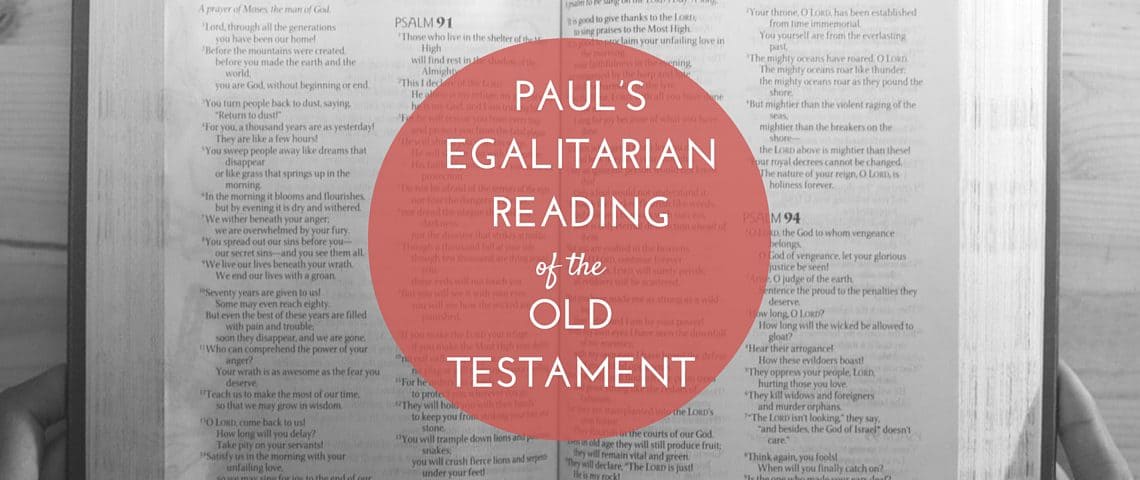For years I struggled with my relationship with the apostle Paul.
On the one hand, as a teenager, I was completely taken with books like Galatians and Philippians and studied chart after chart of the missionary journeys (I am a missionary kid, after all). But as an adult, I had trouble reconciling the “clobber verses” often used to silence women’s voices with the rest of the New Testament.
When I began studying Paul more seriously, it didn’t take long to see that his practice of ministry stands in stark contrast to his apparent prohibitions against women speaking. When we look at the Book of Acts alongside his letters, it is clear that women played key roles in the founding and development of the infant church, and that Paul regarded them highly as ministry partners. Paul’s women coworkers functioned as teachers, apostles, disciples, house church leaders, co-ministers, evangelists, and prophets. Paul also wrote instructions to women who were prophesying and praying in public worship, so we know women were not silent in his churches.
These things are well-documented, so I won’t belabor the point here. [1] Instead, I want to share another piece of the puzzle that supports a more egalitarian view of Paul.
Paul often made his citations of the Old Testament more gender-inclusive than the original passages.
In a 2001 article titled “Do Gender-Sensitive Translations Distort Scripture? Not Necessarily”, Darrell Bock suggests that the Holy Spirit often inspired New Testament writers to change Old Testament texts to communicate God’s message and intentions more clearly. [2] Many of the examples Bock uses to make his point come from the letters of Paul.
The nuances Paul gives to many Old Testament texts point to a decidedly egalitarian viewpoint. He shows no qualms about these changes. In fact, one gets the impression he is working hard to make it clear that the lessons he is sharing are meant for every believer.
Here are four examples:
Old Testament: “There is no fear of God before his eyes” Psalm 36:1
Paul: “As it is written (v. 10) ‘There is no fear of God before their eyes (v. 18)’” Rom 3
Old Testament: “Blessed is he whose transgressions are forgiven, whose sins are covered.” Psalm 32:1
Paul: “Blessed are they whose transgressions are forgiven, whose sins are covered.’” Rom 4:6-7
Old Testament: “How beautiful on the mountains are the feet of him who brings good news.” Is 52:7
Paul: “As it is written, ‘How beautiful are the feet of those who bring good news.’” Rom 10:15
Old Testament: “I will be a father to him and he will be a son to Me.” 2 Sam 7:14a
Paul: “I will be a Father to you [all], and you [all] shall be my sons and daughters.” 2 Cor 6:18
This gender-inclusive pattern in Paul’s writing is intriguing.
Bock writes, “Note also the inclusion of the phrase “you [all]” to drive home the point [2 Corinthians 6:18]. Should we accuse the Spirit of gender bias by the inclusion of daughters here or His/Paul’s move from singular to plural?” Bock then quotes noted biblical (and complementarian) scholar D.A. Carson:
“[The apostle Paul] has taken the third-person singular (“he will be a son to me”) and rewritten it… in terms that expand the masculine “son” into both genders..The least we can say is that the apostle himself does not think that Hebrew singulars must be rendered by Greek singulars, or that Hebrew “son” should never be rendered by the Greek ‘sons and daughters.’ No one, I think, would quickly charge Paul with succumbing to a feminist agenda”. (Carson, 1998, p. 20)
In his Spirit-inspired writing, Paul is intentional about including women in the messages and mandates he sends to the churches. In order to do this, at times Paul made the Old Testament more gender-inclusive than it originally was, as if the Spirit was guiding him along a trajectory of gender reconciliation, healing, and wholeness. What should we make of this?
While we can’t responsibly call Paul an egalitarian in today’s terms, we can certainly see him heading in that direction in his teaching and ministry practice.
In light of this, it is hard to imagine that the apparent restrictions on women in 1 Timothy 2 and 1 Corinthians 14 were anything more than temporary fixes for church-specific issues. These examples, along with other evidence of Paul’s high regard for women, show that Paul was more inclusive of women than we sometimes give him credit for. So why do so many pastors and churches today resist Paul’s example and continue to use Bible translations that have the opposite effect?
If you are still using a gender-exclusive translation, maybe it’s time to follow Paul’s example so that the Gospel message can be understood as clearly now as it was in the early church two thousand years ago. [3]
Notes
[1] More examples of Paul’s egalitarian leanings:
Paul and Women in a Nutshell
Paul’s Greetings to Women Ministers
Paul’s Masculine and Feminine Leadership
[2] Darrell Bock is the Executive Director of Cultural Engagement and Senior Research Professor of New Testament Studies at Dallas Theological Seminary.
[3] More on gender accurate bible translations: Lost in Translation: A Look at 1 Timothy 2:12 by Bob Edwards
References
Bock, D.L. (2001). Do Gender-Sensitive Translations Distort Scripture? Not Necessarily. The Biblical Studies Foundation (www.bible.org).
Carson, D.A. (1998) The Inclusive-Language Debate: A Plea for Realism. Grand Rapids: Baker, 1998, p. 20




8 responses to “Paul’s Egalitarian Reading of the Old Testament”
Ffantastic insights! Saved this piece in Evernote. Love it!
Thanks so much for your ongoing scholarship on this vastly important issue in Church life, Junia Project. We are grateful for your input and your academic excellence as you challenge the social mores of church life.
Thanks so much, Bev. That means a lot coming from a church leader who has been a living example of what God has in mind for women!
Wow! I had never noticed the way Paul tweaked the genders in these specific Bible verses! Such a great help in understanding God’s calling for the women in the church!
On the other hand Luke writes :(As it is written in the law of the Lord, Every male that openeth the womb shall be called holy to the Lord;) while the Old Testament says “Sanctify unto me all the firstborn, whatsoever openeth the womb among the children of Israel, both of man and of beast: it is mine.” Exodus 13:2…
This has bothered me for some time…I wondered why Luke backtracked and specified ‘male’ while Exodus said “Whatsoever”…
So interesting! A great point to bring up in conversations about translations as well as “tradition” arguments.
Fascinating! Thanks, Gail, for another piece of the puzzle to Paul’s views on women. The NT use of the OT is one of my favorite subjects. I’ve never come across this observation before. Good work!
This is really helpful, Gail. To see how Paul understood the word of God should inform readers today in how to understand it as well. There is inclusion, not exclusion, for anyone who belongs to God.